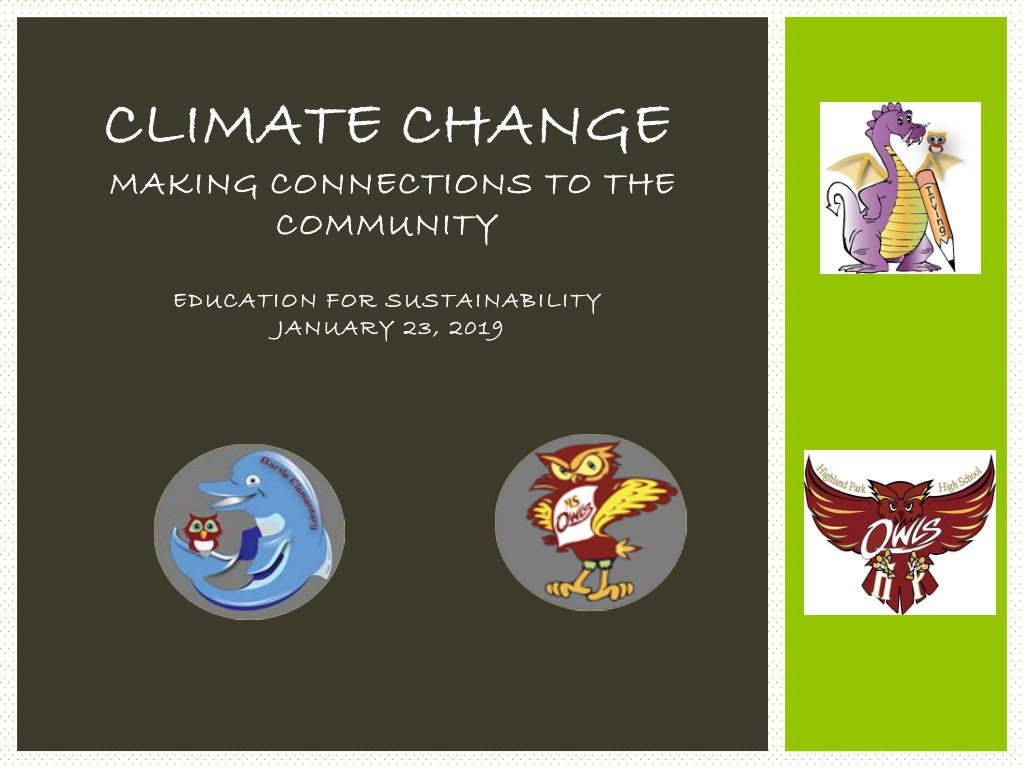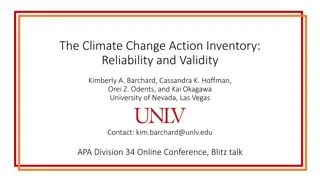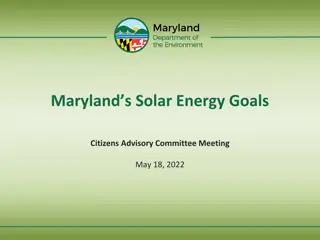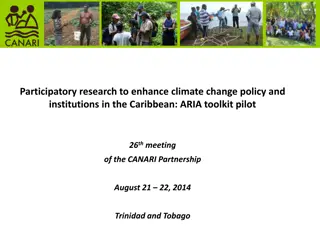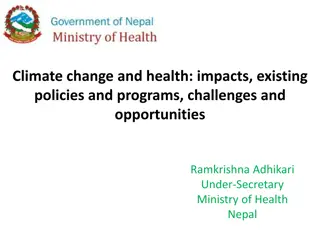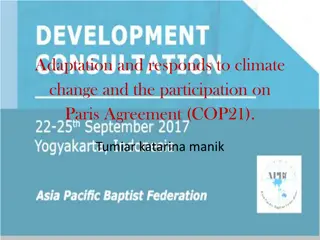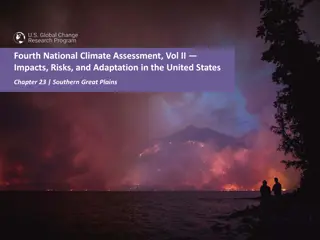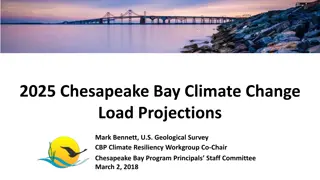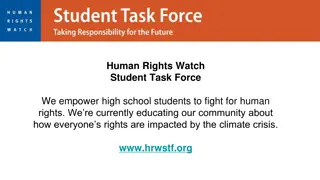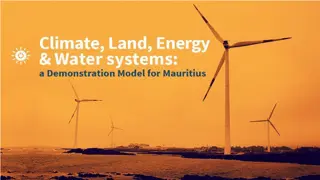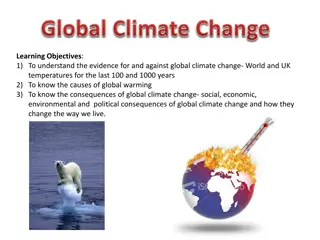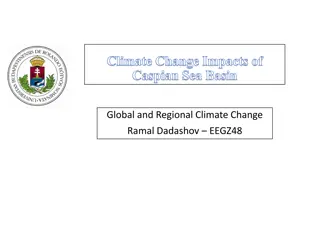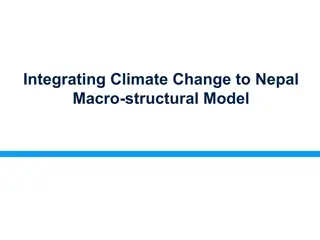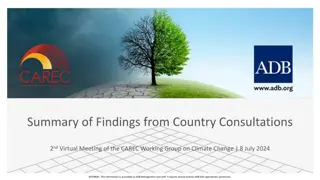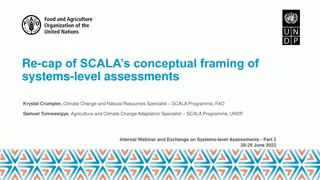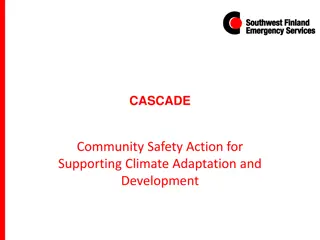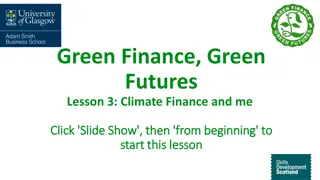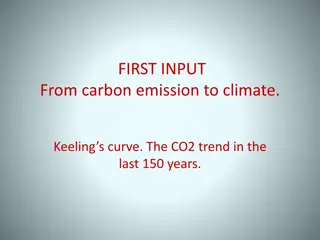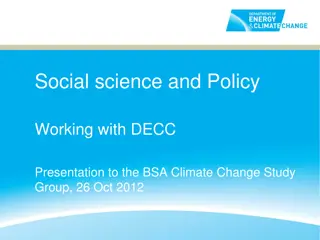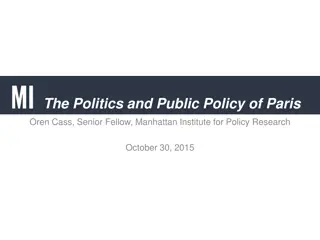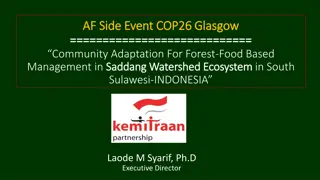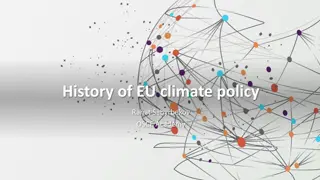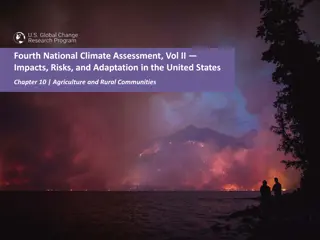Understanding Climate Change Impacts and Actions in the Community
Explore the initiatives of Highland Park School District in educating and conserving for sustainability, alongside tackling climate change fears and vulnerabilities. Unveil the urgency of addressing climate change effects today rather than in the distant future to mitigate its impact on both humans and the environment.
Download Presentation

Please find below an Image/Link to download the presentation.
The content on the website is provided AS IS for your information and personal use only. It may not be sold, licensed, or shared on other websites without obtaining consent from the author. Download presentation by click this link. If you encounter any issues during the download, it is possible that the publisher has removed the file from their server.
E N D
Presentation Transcript
CLIMATE CHANGE CLIMATE CHANGE MAKING CONNECTIONS TO THE MAKING CONNECTIONS TO THE COMMUNITY COMMUNITY EDUCATION FOR SUSTAINABILITY EDUCATION FOR SUSTAINABILITY JANUARY 23, 2019 JANUARY 23, 2019
GREEN TEAM HIGHLAND PARK S GREEN TEAM DECLARATION HIGHLAND PARK S GREEN TEAM DECLARATION: : Highland Park School District will continue a Highland Park School District will continue a district district- -wide effort to educate, conserve, and wide effort to educate, conserve, and explore options to create an eco explore options to create an eco- -friendly community. This has been implemented by community. This has been implemented by sound and progressive methods initiated by sound and progressive methods initiated by students, faculty, administration, and members students, faculty, administration, and members of the Highland Park community. The schools of the Highland Park community. The schools have become a more efficient Green district have become a more efficient Green district through the implementation of better energy through the implementation of better energy saving and environmental practices. The rewards saving and environmental practices. The rewards of our strategy have installed a culture of of our strategy have installed a culture of conservation, reinvestment of saved conservation, reinvestment of saved expenditures for schools and students, and an expenditures for schools and students, and an overall sense of community ownership of overall sense of community ownership of sustainability. sustainability. friendly
CLIMATE CHANGE FEARS CLIMATE CHANGE FEARS
CLIMATE CHANGE. CLIMATE CHANGE .
STATEMENT 1 800 million people are vulnerable to climate change impacts. 800 million people are vulnerable to climate change impacts. FACT! Many of these people are in the developing world and will not have access to resources to protect them from climate change impacts.
STATEMENT 2 We won t feel the effects of climate change for at least 50 We won t feel the effects of climate change for at least 50 years. years. FICTION! Five of the hottest years on record for US were in the last decade. Hurricanes and tropical storms have increased dramatically in the last two decades leading to superstorms like Hurricane Sandy in 2012. We already see animals and plants changing their behaviors due to early springs and late winters from rising temperatures.
STATEMENT 3 If people would stop polluting and start recycling, we will If people would stop polluting and start recycling, we will make real progress to stop climate change. make real progress to stop climate change. FICTION! Recycling is a great way to help the environment, but recycling alone will not solve climate change. The best way to fight climate change is to work wit your community to use less energy and consume less products.
STATEMENT 4 CO CO2 2 emissions from fossil fuel burning remains in the emissions from fossil fuel burning remains in the atmosphere. atmosphere. FICTION! Roughly 50% of CO2 emissions remain in the atmosphere, 25% is absorbed by land plants and the remaining 25% is absorbed by the ocean. Originally, scientists were relieved that the ocean could serve as a CO2 sink for fossil fuel emissions but as time went on, the consequences of CO2 uptake in the ocean became apparent. One consequence is ocean acidification which reduces the amount of carbonate in the ocean. For animals with calcium carbonate shells (like crustaceans, corals, and bivalves), this means it is more difficult to build and sustain strong shells. This leads to instability in ecosystems and can result in an ecosystem collapse.
STATEMENT 5 Climate change results in more CO Climate change results in more CO2 2 in the atmosphere which will help plants grow. will help plants grow. FICTION! Although some crops in some regions will respond positively to increase atmospheric CO2, the vast majority will be in areas with extreme temperature and storm changes that will hurt crop growth. Furthermore, studies have shown that the types of plants the flourish in a higher CO2 environment are weedy species and few edible species so the practical benefits to our community would be nonexistent in the atmosphere which
STATEMENT 6 Closing the ozone hole will help with climate change. Closing the ozone hole will help with climate change. FICTION! The ozone hole and climate change are two completely disconnected environmental issues. We caused the ozone hole by releasing chlorofluorocarbons (CFCs) and halons from products like aerosol spray cans and refrigerants. Climate change is caused by us burning fossil fuels which release carbon dioxide into the atmosphere and eventually it travels into the ocean disturbing the climatological regulation of the planet.
STATEMENT 7 Water vapor is a strong greenhouse gas. Water vapor is a strong greenhouse gas. FACT! Many climate change skeptics love to point out that water vapor is a greenhouse gas which is a fact. However there is only more water vapor in the atmosphere because of increased temperatures. When something else causes increased temperatures, (like more CO2 from burning fossil fuels), the result is more water evaporates into water vapor which traps more heat causing the temperature to go up even more. This is called a positive feedback loop.
STATEMENT 8 We ve known about the greenhouse effect and climate change We ve known about the greenhouse effect and climate change since the 1800s. since the 1800s. FACT! French physicist Joseph Fourier was the first to describe the greenhouse effect in 1824 and propose that releasing large amounts of CO2 would enhance the greenhouse effect.
CLIMATE-FRIENDLY ACTIONS FOR OUR SCHOOLS Become informed. Join the Green Team. Switch it Off. Climate Control. Reduce waste. Make transportation a priority.
EMPOWERING WITH VALUES Protection We must protect and preserve protect and preserve the habitats and ecosystems the habitats and ecosystems we depend on Showing concerns for the concerns for the welfare of others welfare of others is the right things to do Stepping in to ensure the Stepping in to ensure the people s safety and wellbeing people s safety and wellbeing Protection means actively means actively eliminating or reducing risks eliminating or reducing risks Let s work hard to shield and safeguard habitats and people safeguard habitats and people from harm from harm Responsible Management We believe in being responsible responsible with our natural resources We can make a difference by handling problems before they handling problems before they get worse get worse Part of being responsible is by keeping an open mind, looking open mind, looking to evidence and focusing on to evidence and focusing on the best ways to solve a the best ways to solve a problem problem Practical, feasible, step Practical, feasible, step- -by approaches allow use to make real progress on longstanding by- -step step shield and
MATERIALS NEEDED FOR TERRARIUM 2 liter soda bottle (washed and dry) Pebbles Activated Carbon Potting soil Fresh moss Tropical plant 1 small toy animal
DIRECTIONS FOR TERRARIUM Layer your DIY terrarium Layer your DIY terrarium: Add an inch of pebbles to the bottom of the planter. Add a single layer of activated carbon. This will filter the water. Add a barrier layer of moss or pistachio shells. Add potting soil About a inch below the top part of your planter. Plant your rainforest: Plant your rainforest: Plant the tiniest tropical plants you can find. Mini palms and ferns are perfect. Add fresh moss to the top of the soil. Find a toy animal that would enjoy living in your rainforest. Add the final touches: Add the final touches: Lightly water your terrarium. Cut a short slit down the back of the planter, about a an inch. Push the planter together where you cut the slit and place the cover on top. Put your terrarium in a spot where it ll get plenty of INDIRECT sunlight. There s no need to water your rainforest in the future. Moisture will form on the inside of your terrarium and on the plants. That moisture will drip down and water the soil.
ADDITIONAL RESOURCES Frameworks Institute https://frameworksinstitute.org/climate- change-and-the-ocean.html https://frameworksacademy.org/collections/specialized- sponsored-courses/products/changing-the-conversation-on- ocean-and-climate-change NNOCCI Climate Interpreter https://climateinterpreter.org/ Common Climate Skeptic Arguments https://grist.org/series/skeptics/ Stabilizing Carbon Wedge Game https://cmi.princeton.edu/wedges/game Sea Ice vs Land Ice Activity https://www.jpl.nasa.gov/edu/teach/activity/whats-causing-sea- level-rise-land-ice-vs-sea-ice/
